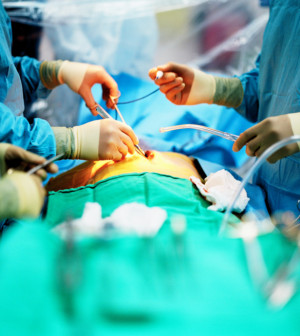- Double Mastectomy May Offer No Survival Benefit to Women With Breast Cancer
- Toxic Lead Found in Cinnamon Product, FDA Says
- Certain Abbott Blood Sugar Monitors May Give Incorrect Readings
- Athletes Can Expect High Ozone, Pollen Counts for Paris Olympics
- Fake Oxycontin Pills Widespread and Potentially Deadly: Report
- Shingles Vaccine Could Lower Dementia Risk
- Your Odds for Accidental Gun Death Rise Greatly in Certain States
- Kids From Poorer Families Less Likely to Survive Cancer
- Tough Workouts Won’t Trigger Cardiac Arrest in Folks With Long QT Syndrome
- At-Home Colon Cancer Test Can Save Lives
Partial HPV Vaccine Series May Help Prevent Genital Warts in Girls


Girls given two doses of the human papillomavirus (HPV) vaccine instead of the recommended three doses appear to have some protection against genital warts, Swedish researchers report.
Whether two doses is enough to protect against cervical cancer, however, isn’t known and experts remain wary of partial vaccination since the primary goal of the vaccine is to protect women from this potentially deadly cancer.
“This is the first study investigating the effectiveness of the HPV vaccine in the population by dose level,” said lead researcher Lisen Arnheim-Dahlstrom, an associate professor in the department of medical epidemiology and biostatistics at the Karolinska Institute, in Stockholm.
“It is important to bear in mind that we have been studying genital warts, which is the first measurable disease outcome that we can study after vaccination because of its short incubation time. Cervical cancer takes a much longer time to develop than genital warts and is not as common,” she said.
Arnheim-Dahlstrom cautioned that they did not study the vaccine’s effectiveness in preventing cervical cancer. “The take-home message is to stick to the recommended dose schedule until other recommendations are made,” she said.
The report was published in the Feb. 12 issue of the Journal of the American Medical Association.
Dr. Mark Messing, a gynecologic oncologist at Texas Oncology, an affiliate of the U.S. Oncology Network, said, “HPV infection can cause genital warts and cancer of the lower female genital tract, including the cervix, vulva, vagina, as well as cancer of the anus, tongue and throat.”
While there are more than a hundred different subtypes of the virus, only a few are considered high-risk, he explained. Two vaccines — Cervarix and Gardasil — are available against the two most common types of HPV that cause cervical cancer and some other types of cancer. Gardasil also covers the two most common HPV strains that cause genital warts. Both vaccines are given in three injections over six months.
The incubation time for a genital wart infection is only about one to six months after exposure, compared with the 10 to 20 years usually needed for cancer to develop after HPV infection, Messing said.
“This study does not provide any information on how effective two versus three doses of vaccine will be in preventing the more serious disease of cervical or other cancer,” he said.
For the study Arnheim-Dahlstrom and colleagues collected data from national Swedish health registries on more than 1 million girls and women aged 10 to 24 who were followed between 2006 and 2010.
Of more than 20,000 cases of genital warts, only 322 happened after a female had received at least one dose of the vaccine, the researchers found.
Although the maximum reduction in risk was found after three doses, two doses also were protective, but to a lesser degree.
According to the researchers, the difference between three and two doses was that with two doses there would be 59 more cases of genital warts per 100,000 women who were observed for one year.
Since the vaccine is most effective before exposure to HPV, the U.S. Centers for Disease Control and Prevention recommends that boys and girls get the full three doses of the vaccine starting at age 11 and 12.
According to the CDC, in 2012, about 54 percent of U.S. girls have had at least one dose of the HPV vaccine, but only 33 percent have received all three recommended doses.
Among boys, about 20 percent had received one dose of the vaccine, but slightly less than 7 percent had received all three doses, the agency noted.
Commenting on the study, Dr. Mitchell Maiman, chairman of obstetrics and gynecology at Staten Island University Hospital in New York City, said, “This is very preliminary. The only protocol that’s approved right now is three shots, and we are not doing that great with three shots,” he said.
Maiman noted that the three shots cost about $400, and fewer shots could be less expensive, but whether or not fewer doses would be protective against cancer isn’t known.
More information
To learn more about HPV vaccination, visit the U.S. Centers for Disease Control and Prevention.
Source: HealthDay
Copyright © 2024 HealthDay. All rights reserved.










